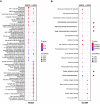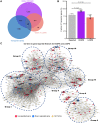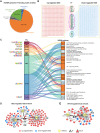Distinct placental molecular processes associated with early-onset and late-onset preeclampsia
- PMID: 33754042
- PMCID: PMC7978310
- DOI: 10.7150/thno.56141
Distinct placental molecular processes associated with early-onset and late-onset preeclampsia
Abstract
Background: Patients with preeclampsia display a spectrum of onset time and severity of clinical presentation, yet the underlying molecular bases for the early-onset and late-onset clinical subtypes are not known. Although several transcriptome studies have been done on placentae from PE patients, only a small number of differentially expressed genes have been identified due to very small sample sizes and no distinguishing of clinical subtypes. Methods: We carried out RNA-seq on 65 high-quality placenta samples, including 33 from 30 patients and 32 from 30 control subjects, to search for dysregulated genes and the molecular network and pathways they are involved in. Results: We identified two functionally distinct sets of dysregulated genes in the two major subtypes: 2,977 differentially expressed genes in early-onset severe preeclampsia, which are enriched with metabolism-related pathways, notably transporter functions; and 375 differentially expressed genes in late-onset severe preeclampsia, which are enriched with immune-related pathways. We also identified some key transcription factors, which may drive the widespread gene dysregulation in both early-onset and late-onset patients. Conclusion: These results suggest that early-onset and late-onset severe preeclampsia have different molecular mechanisms, whereas the late-onset mild preeclampsia may have no placenta-specific causal factors. A few regulators may be the key drivers of the dysregulated molecular pathways.
Keywords: clinical subtypes; molecular mechanism; placenta; preeclampsia; transcriptome.
© The author(s).
Conflict of interest statement
Competing Interests: The authors have declared that no competing interest exists.
Figures





Similar articles
-
Landscape of Dysregulated Placental RNA Editing Associated With Preeclampsia.Hypertension. 2020 Jun;75(6):1532-1541. doi: 10.1161/HYPERTENSIONAHA.120.14756. Epub 2020 Apr 20. Hypertension. 2020. PMID: 32306769
-
Microarray profiling reveals that placental transcriptomes of early-onset HELLP syndrome and preeclampsia are similar.Placenta. 2011 Feb;32 Suppl(0):S21-9. doi: 10.1016/j.placenta.2010.04.014. Epub 2010 Jun 11. Placenta. 2011. PMID: 20541258 Free PMC article.
-
Identification of Differentially Expressed Genes and Signaling Pathways in Placenta Tissue of Early-Onset and Late-Onset Pre-Eclamptic Pregnancies by Integrated Bioinformatics Analysis.Med Sci Monit. 2020 Jun 4;26:e921997. doi: 10.12659/MSM.921997. Med Sci Monit. 2020. PMID: 32497025 Free PMC article.
-
Low- and high-level information analyses of transcriptome connecting endometrial-decidua-placental origin of preeclampsia subtypes: A preliminary study.Pac Symp Biocomput. 2024;29:549-563. Pac Symp Biocomput. 2024. PMID: 38160306
-
A Review of Candidate Genes and Pathways in Preeclampsia-An Integrated Bioinformatical Analysis.Biology (Basel). 2020 Mar 27;9(4):62. doi: 10.3390/biology9040062. Biology (Basel). 2020. PMID: 32230784 Free PMC article. Review.
Cited by
-
Hierarchical lncRNA regulatory network in early-onset severe preeclampsia.BMC Biol. 2024 Jul 29;22(1):159. doi: 10.1186/s12915-024-01959-1. BMC Biol. 2024. PMID: 39075446 Free PMC article.
-
Circulating Chemerin Is Elevated in Women With Preeclampsia.Endocrinology. 2023 Mar 13;164(5):bqad041. doi: 10.1210/endocr/bqad041. Endocrinology. 2023. PMID: 36882076 Free PMC article.
-
Oxidative Stress, Lipid Peroxidation and Ferroptosis Are Major Pathophysiological Signatures in the Placental Tissue of Women with Late-Onset Preeclampsia.Antioxidants (Basel). 2024 May 11;13(5):591. doi: 10.3390/antiox13050591. Antioxidants (Basel). 2024. PMID: 38790696 Free PMC article.
-
Development and validation of nomograms to predict clinical outcomes of preeclampsia.Front Endocrinol (Lausanne). 2024 Mar 14;15:1292458. doi: 10.3389/fendo.2024.1292458. eCollection 2024. Front Endocrinol (Lausanne). 2024. PMID: 38549768 Free PMC article.
-
ALKBH1 knockdown promotes the growth, migration and invasion of HTR-8/SVneo cells through regulating the m5C modification PSMD14.Sci Rep. 2025 Mar 1;15(1):7345. doi: 10.1038/s41598-025-91233-3. Sci Rep. 2025. PMID: 40025166 Free PMC article.
References
-
- Brown MA, Magee LA, Kenny LC, Karumanchi SA, McCarthy FP, Saito S. et al. Hypertensive Disorders of Pregnancy: ISSHP Classification, Diagnosis, and Management Recommendations for International Practice. Hypertension. 2018;72:24–43. - PubMed
-
- Mol BWJ, Roberts CT, Thangaratinam S, Magee LA, de Groot CJM, Hofmeyr GJ. Pre-eclampsia. Lancet. 2016;387:999–1011. - PubMed
-
- Raymond D, Peterson E. A critical review of early-onset and late-onset preeclampsia. Obstet Gynecol Surv. 2011;66:497–506. - PubMed
-
- Herzog EM, Eggink AJ, Reijnierse A, Kerkhof MA, de Krijger RR, Roks AJ. et al. Impact of early- and late-onset preeclampsia on features of placental and newborn vascular health. Placenta. 2017;49:72–9. - PubMed
Publication types
MeSH terms
Substances
LinkOut - more resources
Full Text Sources
Other Literature Sources

